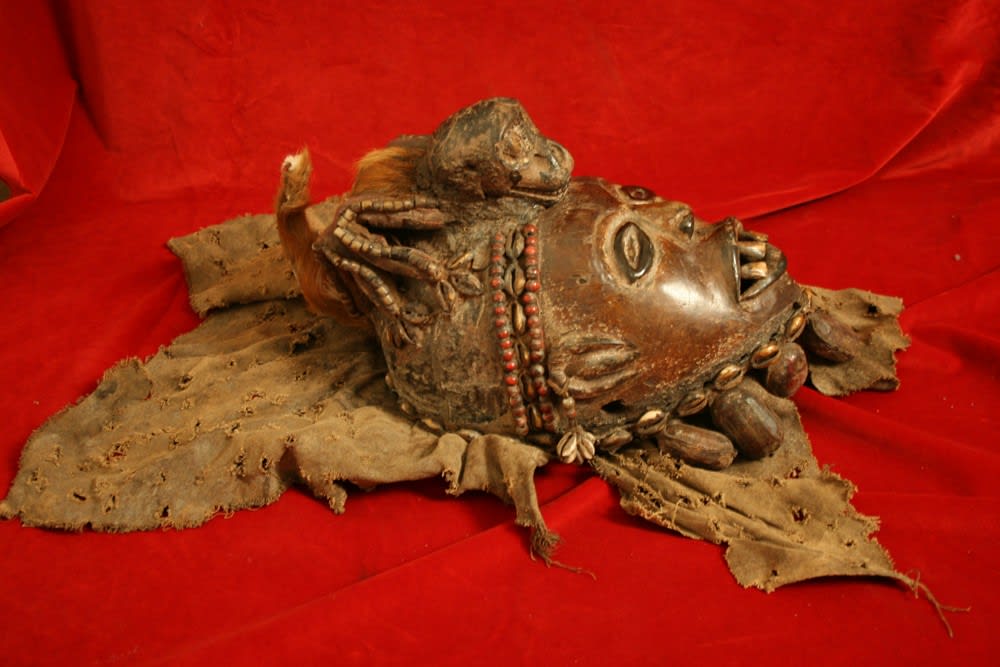Kongo Wooden Mask, 20th Century CE
Wood, Fur, Teeth
PF.1494 (LSO)
Further images
This impressive mask is highly mysterious in terms of origin, and is a highly remarkable piece of construction. The mask itself is fairly small, with highly polished wood highlighted with...
This impressive mask is highly mysterious in terms of origin, and is a highly remarkable piece of construction. The mask itself is fairly small, with highly polished wood highlighted with cervid teeth and ringed eyes. The most imposing part of the mask is the superstructure, which includes a monkey skull, beads, cowries, textile and fur. The inclusion of all this “fetish” material makes it apparent that the piece comes from the former Zaire, where many tribes (notably the Kongo and the Songye) attach magical materials to masks and sculptures to endow them with authority to solve problems and to supernaturally intervene in mortal affairs. The tradition is also seen in the Bete group of the Ivory Coast. This particular mask form is essentially unique; however, the materials attached thereto make it likely to be a Kongo piece.
The Kongo (or Bakongo) people live in the Democratic Republic of the Congo, Angola and the Congo. They originally lived in a series of loosely-connected yet autonomous kingdoms, followed by considerable turmoil and the arrival of the European forces at the start of the 16th century. They had a reasonably peaceful relationship with the foreigners, so their material culture has survived largely intact. Indigenous Kongo society was based around the kingship model, not unlike that of the Nigerian Kingdom of Benin. Their religious beliefs have a far wider circulation, and are based around a reverence for the dead who are believed to be able to assist in the determination of future destinies. The most notable pieces of Kongo sculpture are the Nkisi Nkondi figures – often referred to as nail fetishes – which carry a packet of magical materials known as a bilongo; the figures are insulted and “hurt” with explosions and nails so that they will carry out the wishes of their tormentor. Various other categories also exist, such as the ntadi limestone grave markers and maternity figures with characteristic open-mouths, almond-shaped eyes and detailed surface work.
This piece is identified with the Kongo on the basis of stylistic similarity. However, the attribution is largely irrelevant, as this is a striking and impressive piece of African art.
The Kongo (or Bakongo) people live in the Democratic Republic of the Congo, Angola and the Congo. They originally lived in a series of loosely-connected yet autonomous kingdoms, followed by considerable turmoil and the arrival of the European forces at the start of the 16th century. They had a reasonably peaceful relationship with the foreigners, so their material culture has survived largely intact. Indigenous Kongo society was based around the kingship model, not unlike that of the Nigerian Kingdom of Benin. Their religious beliefs have a far wider circulation, and are based around a reverence for the dead who are believed to be able to assist in the determination of future destinies. The most notable pieces of Kongo sculpture are the Nkisi Nkondi figures – often referred to as nail fetishes – which carry a packet of magical materials known as a bilongo; the figures are insulted and “hurt” with explosions and nails so that they will carry out the wishes of their tormentor. Various other categories also exist, such as the ntadi limestone grave markers and maternity figures with characteristic open-mouths, almond-shaped eyes and detailed surface work.
This piece is identified with the Kongo on the basis of stylistic similarity. However, the attribution is largely irrelevant, as this is a striking and impressive piece of African art.





